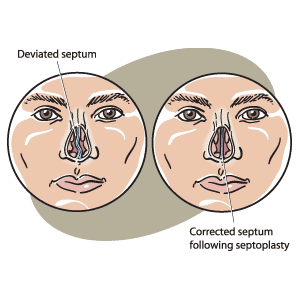Septoplasty Complications Avoidance And Management. The septoplasty surgeon must be aware of all the possible complications that may. Septoplasty is typically performed to correct a deviated septum in a patient who Initial management includes humidification, antibiotic irrigation, avoidance of rhinotillexis (nose picking), and emollients.

Tanveer Janjua discusses the complications of septoplasty.
Questions about Septoplasty and complication, with answers from board-certified doctors.
A septoplasty is performed to correct a deviated septum, alleviating breathing difficulties and reduced airflow of the nasal airway. You will have to decide if the benefits will achieve your goals and if the risks and potential complications of septoplasty are acceptable. Ideally, the septum should run down the center of the nose. Complications of septoplasty techniques are similar to those of BAS and include vascular injury, perforation, significant bleeding or blood loss, thromboembolic events including stroke, heart block, or serious arrhythmias, and death. The septoplasty surgeon must be aware of all the possible complications that may. What are the most common side effects or complications?
Septoplasty refers to surgical manipulation and/or removal of deviated septal cartilage and/or bone to correct a nasal septal defor-mity. D.) who has received additional training in surgery. Septoplasty may be necessary to correct a deviated septum and alleviate breathing difficulties. Complications of septoplasty techniques are similar to those of BAS and include vascular injury, perforation, significant bleeding or blood loss, thromboembolic events including stroke, heart block, or serious arrhythmias, and death. Ideally, the septum should run down the center of the nose. Septoplasty is a common surgical procedure used for correction of the nasal obstruction caused by a deviated septum.
To avoid nose bleeding, it is important for the patient to keep their head elevated, and to avoid any straining during bowel movements or exercise. Purpose: Septoplasty is a common surgical procedure used for correction of the nasal obstruction caused by a deviated septum. Ideally, the septum should run down the center of the nose.






